CHC33015: Assessment Workbook: Support Independence and Wellbeing
VerifiedAdded on 2022/12/16
|81
|13055
|1
Homework Assignment
AI Summary
This assessment workbook, designed for the CHC33015 Certificate III in Individual Support, focuses on providing individualised support, promoting independence, and enhancing wellbeing. The workbook includes a detailed introduction outlining the context, assessment requirements, and methods used. It comprises knowledge assessments, covering principles of person-centred, strength-centred, and active support, along with reporting and documentation processes. Case studies are a core component, presenting scenarios involving aged care clients, requiring students to apply their knowledge through role-play tasks and critical analysis. The workbook also covers the roles and responsibilities of various care providers, service delivery models like residential and respite care, and the importance of recognizing healthy body systems. The document provides comprehensive resources for students to demonstrate their understanding and skills in providing holistic care and support.
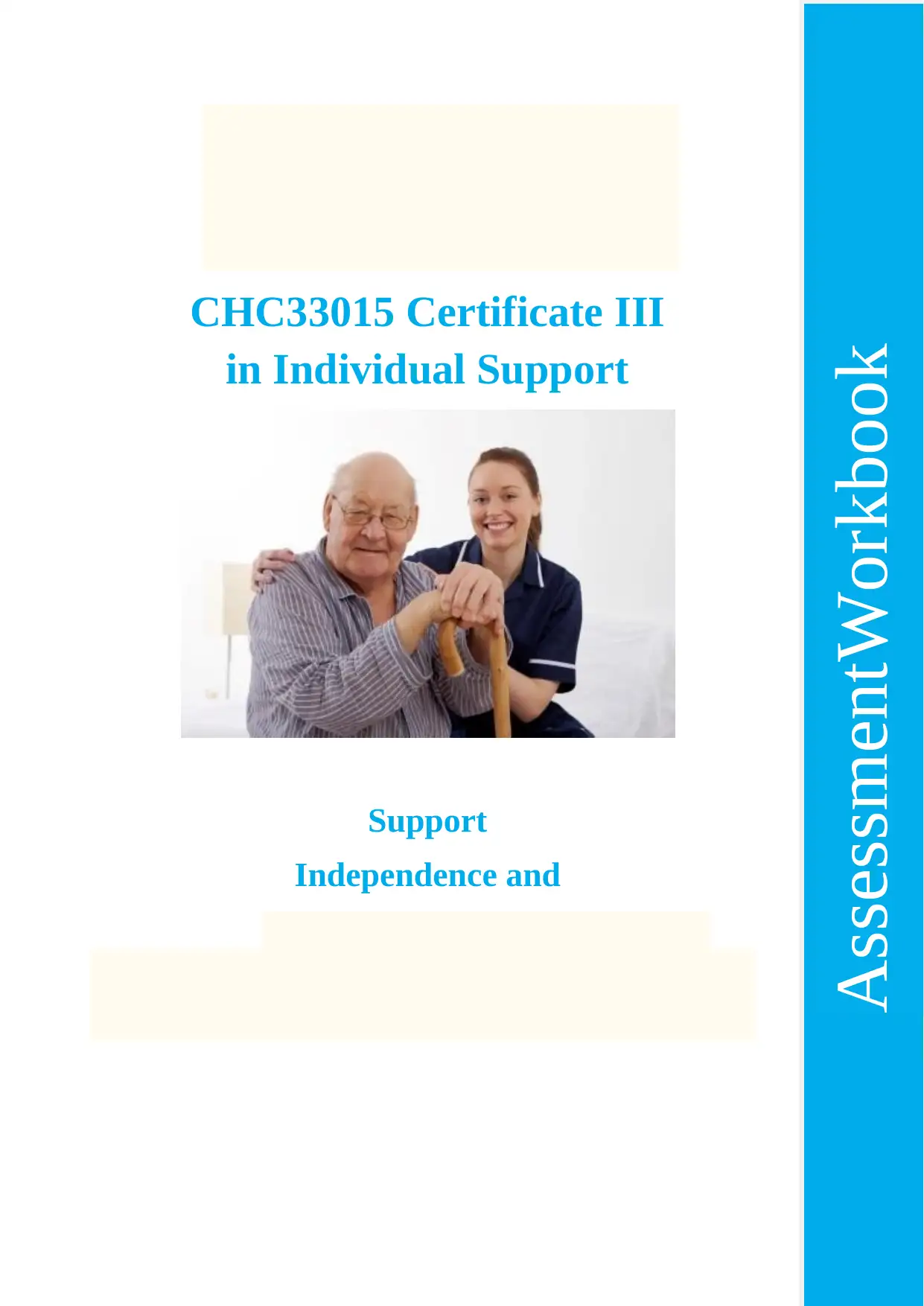
CHC33015 Certificate III
in Individual Support
Support
Independence and
Wellbeing
AssessmentWorkbook
in Individual Support
Support
Independence and
Wellbeing
AssessmentWorkbook
Paraphrase This Document
Need a fresh take? Get an instant paraphrase of this document with our AI Paraphraser
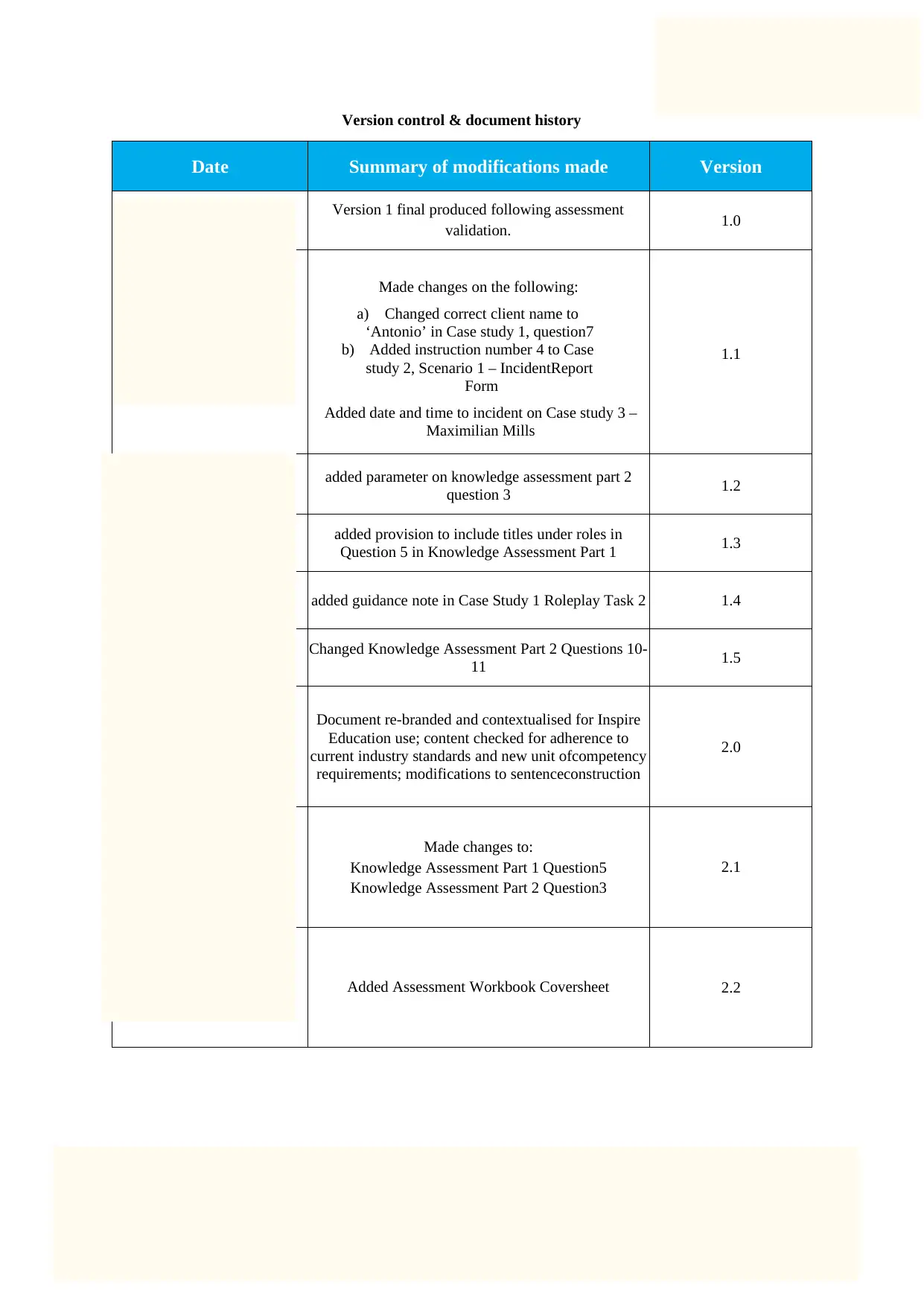
Version control & document history
Date Summary of modifications made Version
Version 1 final produced following assessment
validation. 1.0
Made changes on the following:
a) Changed correct client name to
‘Antonio’ in Case study 1, question7
b) Added instruction number 4 to Case
study 2, Scenario 1 – IncidentReport
Form
Added date and time to incident on Case study 3 –
Maximilian Mills
1.1
added parameter on knowledge assessment part 2
question 3 1.2
added provision to include titles under roles in
Question 5 in Knowledge Assessment Part 1 1.3
added guidance note in Case Study 1 Roleplay Task 2 1.4
Changed Knowledge Assessment Part 2 Questions 10-
11 1.5
Document re-branded and contextualised for Inspire
Education use; content checked for adherence to
current industry standards and new unit ofcompetency
requirements; modifications to sentenceconstruction
2.0
Made changes to:
Knowledge Assessment Part 1 Question5
Knowledge Assessment Part 2 Question3
2.1
Added Assessment Workbook Coversheet 2.2
Date Summary of modifications made Version
Version 1 final produced following assessment
validation. 1.0
Made changes on the following:
a) Changed correct client name to
‘Antonio’ in Case study 1, question7
b) Added instruction number 4 to Case
study 2, Scenario 1 – IncidentReport
Form
Added date and time to incident on Case study 3 –
Maximilian Mills
1.1
added parameter on knowledge assessment part 2
question 3 1.2
added provision to include titles under roles in
Question 5 in Knowledge Assessment Part 1 1.3
added guidance note in Case Study 1 Roleplay Task 2 1.4
Changed Knowledge Assessment Part 2 Questions 10-
11 1.5
Document re-branded and contextualised for Inspire
Education use; content checked for adherence to
current industry standards and new unit ofcompetency
requirements; modifications to sentenceconstruction
2.0
Made changes to:
Knowledge Assessment Part 1 Question5
Knowledge Assessment Part 2 Question3
2.1
Added Assessment Workbook Coversheet 2.2
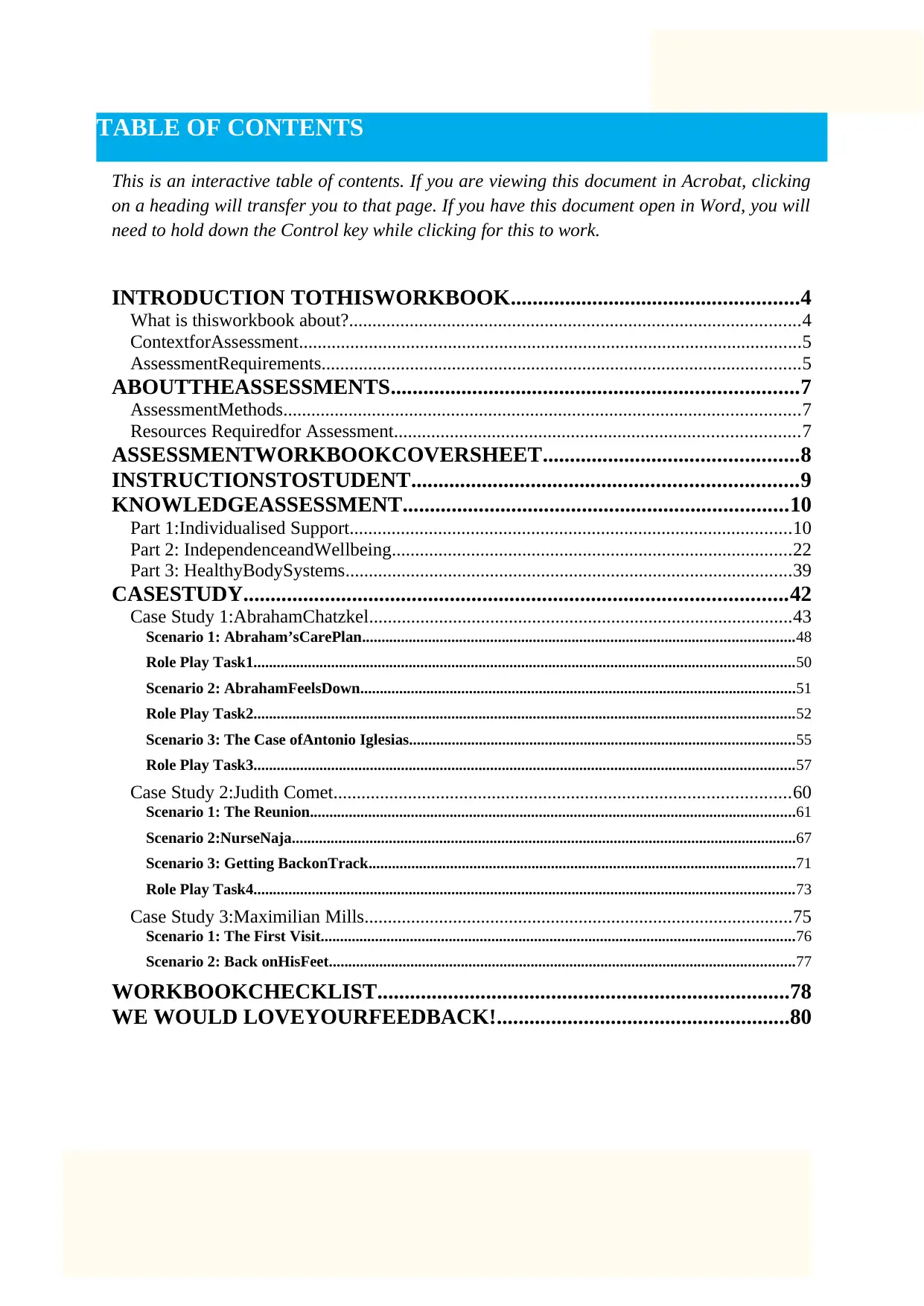
TABLE OF CONTENTS
This is an interactive table of contents. If you are viewing this document in Acrobat, clicking
on a heading will transfer you to that page. If you have this document open in Word, you will
need to hold down the Control key while clicking for this to work.
INTRODUCTION TOTHISWORKBOOK.....................................................4
What is thisworkbook about?.................................................................................................4
ContextforAssessment............................................................................................................5
AssessmentRequirements.......................................................................................................5
ABOUTTHEASSESSMENTS...........................................................................7
AssessmentMethods...............................................................................................................7
Resources Requiredfor Assessment.......................................................................................7
ASSESSMENTWORKBOOKCOVERSHEET...............................................8
INSTRUCTIONSTOSTUDENT.......................................................................9
KNOWLEDGEASSESSMENT.......................................................................10
Part 1:Individualised Support...............................................................................................10
Part 2: IndependenceandWellbeing......................................................................................22
Part 3: HealthyBodySystems................................................................................................39
CASESTUDY....................................................................................................42
Case Study 1:AbrahamChatzkel...........................................................................................43
Scenario 1: Abraham’sCarePlan...............................................................................................................48
Role Play Task1...........................................................................................................................................50
Scenario 2: AbrahamFeelsDown................................................................................................................51
Role Play Task2...........................................................................................................................................52
Scenario 3: The Case ofAntonio Iglesias...................................................................................................55
Role Play Task3...........................................................................................................................................57
Case Study 2:Judith Comet..................................................................................................60
Scenario 1: The Reunion.............................................................................................................................61
Scenario 2:NurseNaja..................................................................................................................................67
Scenario 3: Getting BackonTrack..............................................................................................................71
Role Play Task4...........................................................................................................................................73
Case Study 3:Maximilian Mills............................................................................................75
Scenario 1: The First Visit..........................................................................................................................76
Scenario 2: Back onHisFeet........................................................................................................................77
WORKBOOKCHECKLIST............................................................................78
WE WOULD LOVEYOURFEEDBACK!......................................................80
This is an interactive table of contents. If you are viewing this document in Acrobat, clicking
on a heading will transfer you to that page. If you have this document open in Word, you will
need to hold down the Control key while clicking for this to work.
INTRODUCTION TOTHISWORKBOOK.....................................................4
What is thisworkbook about?.................................................................................................4
ContextforAssessment............................................................................................................5
AssessmentRequirements.......................................................................................................5
ABOUTTHEASSESSMENTS...........................................................................7
AssessmentMethods...............................................................................................................7
Resources Requiredfor Assessment.......................................................................................7
ASSESSMENTWORKBOOKCOVERSHEET...............................................8
INSTRUCTIONSTOSTUDENT.......................................................................9
KNOWLEDGEASSESSMENT.......................................................................10
Part 1:Individualised Support...............................................................................................10
Part 2: IndependenceandWellbeing......................................................................................22
Part 3: HealthyBodySystems................................................................................................39
CASESTUDY....................................................................................................42
Case Study 1:AbrahamChatzkel...........................................................................................43
Scenario 1: Abraham’sCarePlan...............................................................................................................48
Role Play Task1...........................................................................................................................................50
Scenario 2: AbrahamFeelsDown................................................................................................................51
Role Play Task2...........................................................................................................................................52
Scenario 3: The Case ofAntonio Iglesias...................................................................................................55
Role Play Task3...........................................................................................................................................57
Case Study 2:Judith Comet..................................................................................................60
Scenario 1: The Reunion.............................................................................................................................61
Scenario 2:NurseNaja..................................................................................................................................67
Scenario 3: Getting BackonTrack..............................................................................................................71
Role Play Task4...........................................................................................................................................73
Case Study 3:Maximilian Mills............................................................................................75
Scenario 1: The First Visit..........................................................................................................................76
Scenario 2: Back onHisFeet........................................................................................................................77
WORKBOOKCHECKLIST............................................................................78
WE WOULD LOVEYOURFEEDBACK!......................................................80
⊘ This is a preview!⊘
Do you want full access?
Subscribe today to unlock all pages.

Trusted by 1+ million students worldwide
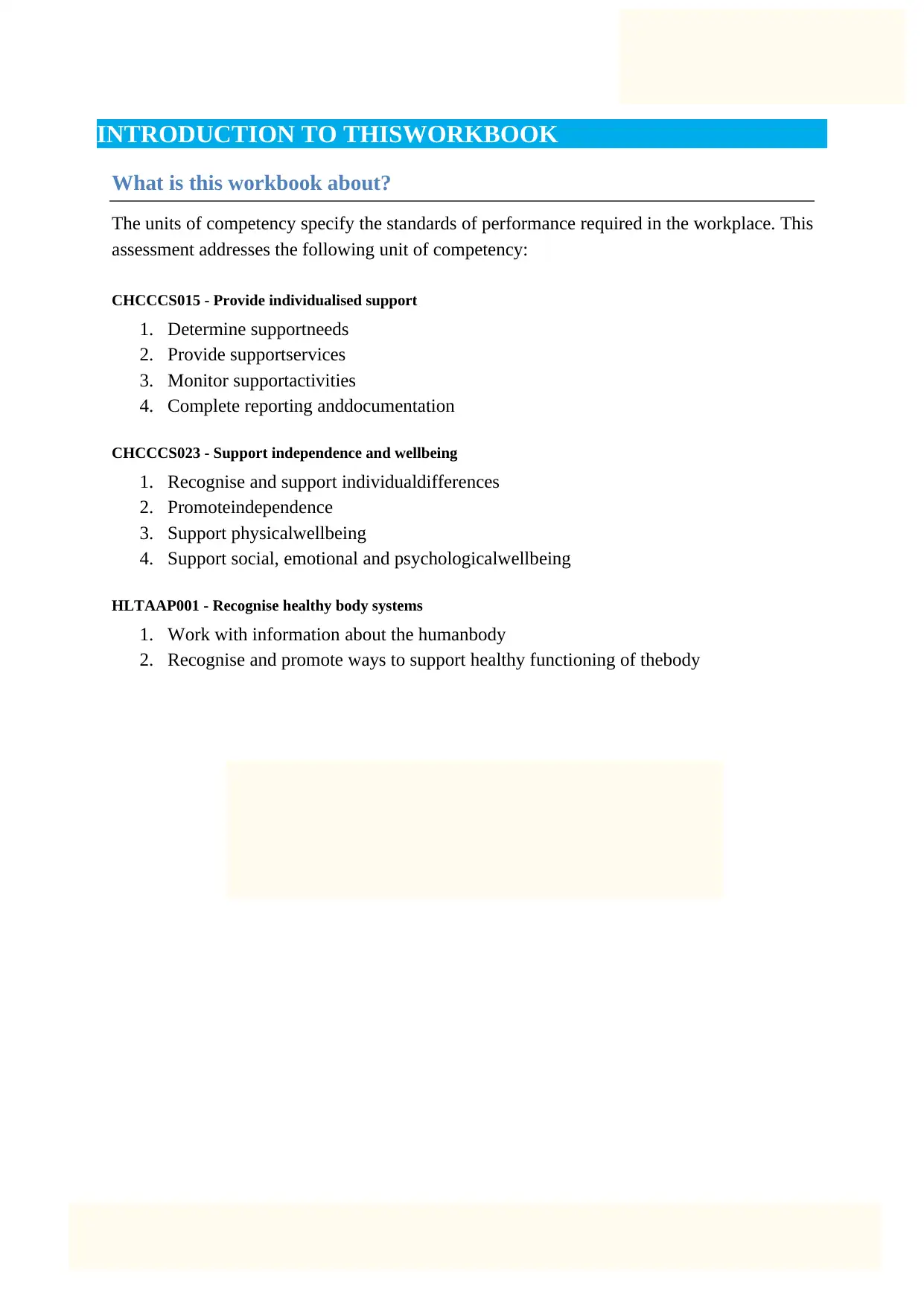
INTRODUCTION TO THISWORKBOOK
What is this workbook about?
The units of competency specify the standards of performance required in the workplace. This
assessment addresses the following unit of competency:
CHCCCS015 - Provide individualised support
1. Determine supportneeds
2. Provide supportservices
3. Monitor supportactivities
4. Complete reporting anddocumentation
CHCCCS023 - Support independence and wellbeing
1. Recognise and support individualdifferences
2. Promoteindependence
3. Support physicalwellbeing
4. Support social, emotional and psychologicalwellbeing
HLTAAP001 - Recognise healthy body systems
1. Work with information about the humanbody
2. Recognise and promote ways to support healthy functioning of thebody
What is this workbook about?
The units of competency specify the standards of performance required in the workplace. This
assessment addresses the following unit of competency:
CHCCCS015 - Provide individualised support
1. Determine supportneeds
2. Provide supportservices
3. Monitor supportactivities
4. Complete reporting anddocumentation
CHCCCS023 - Support independence and wellbeing
1. Recognise and support individualdifferences
2. Promoteindependence
3. Support physicalwellbeing
4. Support social, emotional and psychologicalwellbeing
HLTAAP001 - Recognise healthy body systems
1. Work with information about the humanbody
2. Recognise and promote ways to support healthy functioning of thebody
Paraphrase This Document
Need a fresh take? Get an instant paraphrase of this document with our AI Paraphraser
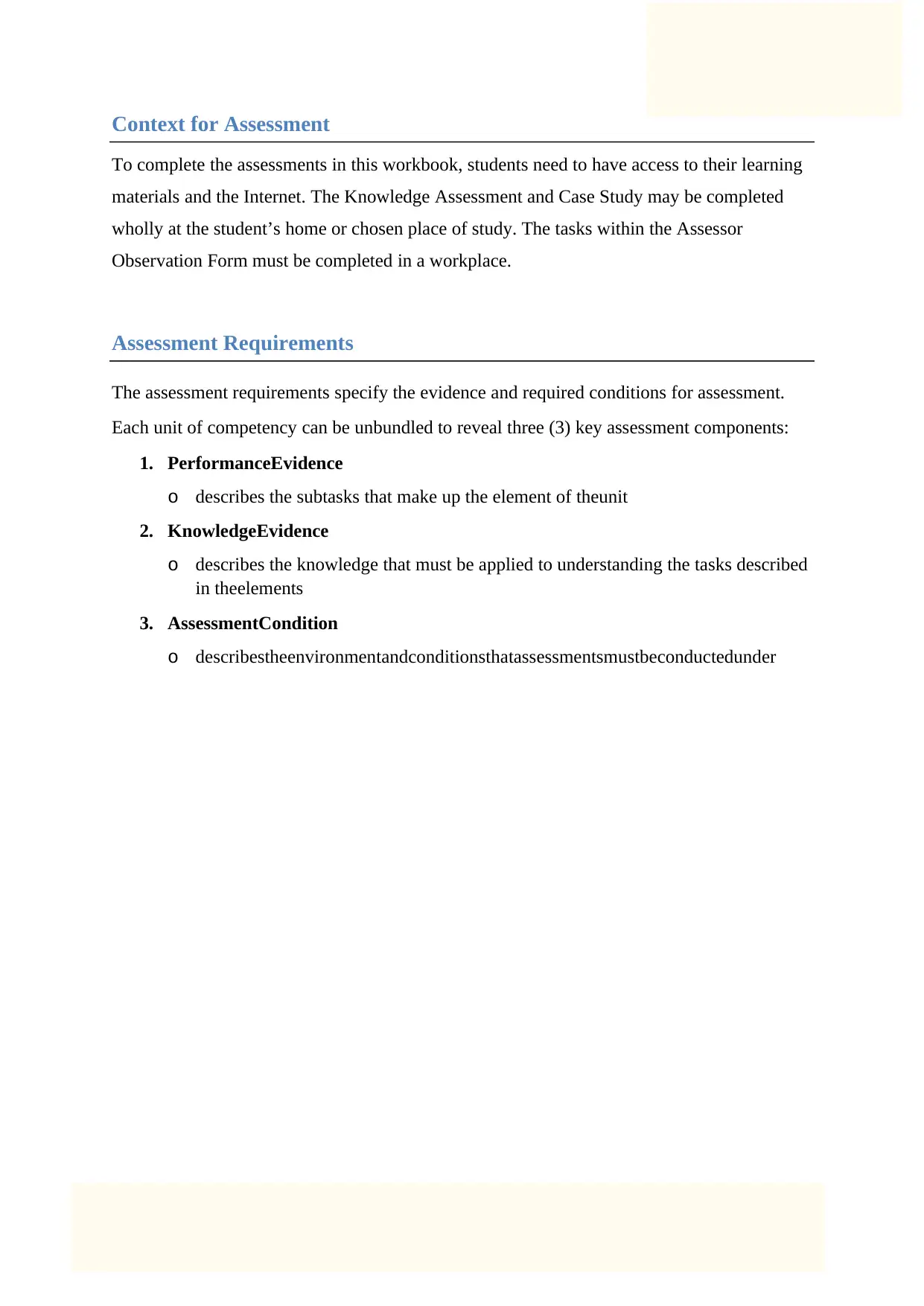
Context for Assessment
To complete the assessments in this workbook, students need to have access to their learning
materials and the Internet. The Knowledge Assessment and Case Study may be completed
wholly at the student’s home or chosen place of study. The tasks within the Assessor
Observation Form must be completed in a workplace.
Assessment Requirements
The assessment requirements specify the evidence and required conditions for assessment.
Each unit of competency can be unbundled to reveal three (3) key assessment components:
1. PerformanceEvidence
o describes the subtasks that make up the element of theunit
2. KnowledgeEvidence
o describes the knowledge that must be applied to understanding the tasks described
in theelements
3. AssessmentCondition
o describestheenvironmentandconditionsthatassessmentsmustbeconductedunder
To complete the assessments in this workbook, students need to have access to their learning
materials and the Internet. The Knowledge Assessment and Case Study may be completed
wholly at the student’s home or chosen place of study. The tasks within the Assessor
Observation Form must be completed in a workplace.
Assessment Requirements
The assessment requirements specify the evidence and required conditions for assessment.
Each unit of competency can be unbundled to reveal three (3) key assessment components:
1. PerformanceEvidence
o describes the subtasks that make up the element of theunit
2. KnowledgeEvidence
o describes the knowledge that must be applied to understanding the tasks described
in theelements
3. AssessmentCondition
o describestheenvironmentandconditionsthatassessmentsmustbeconductedunder
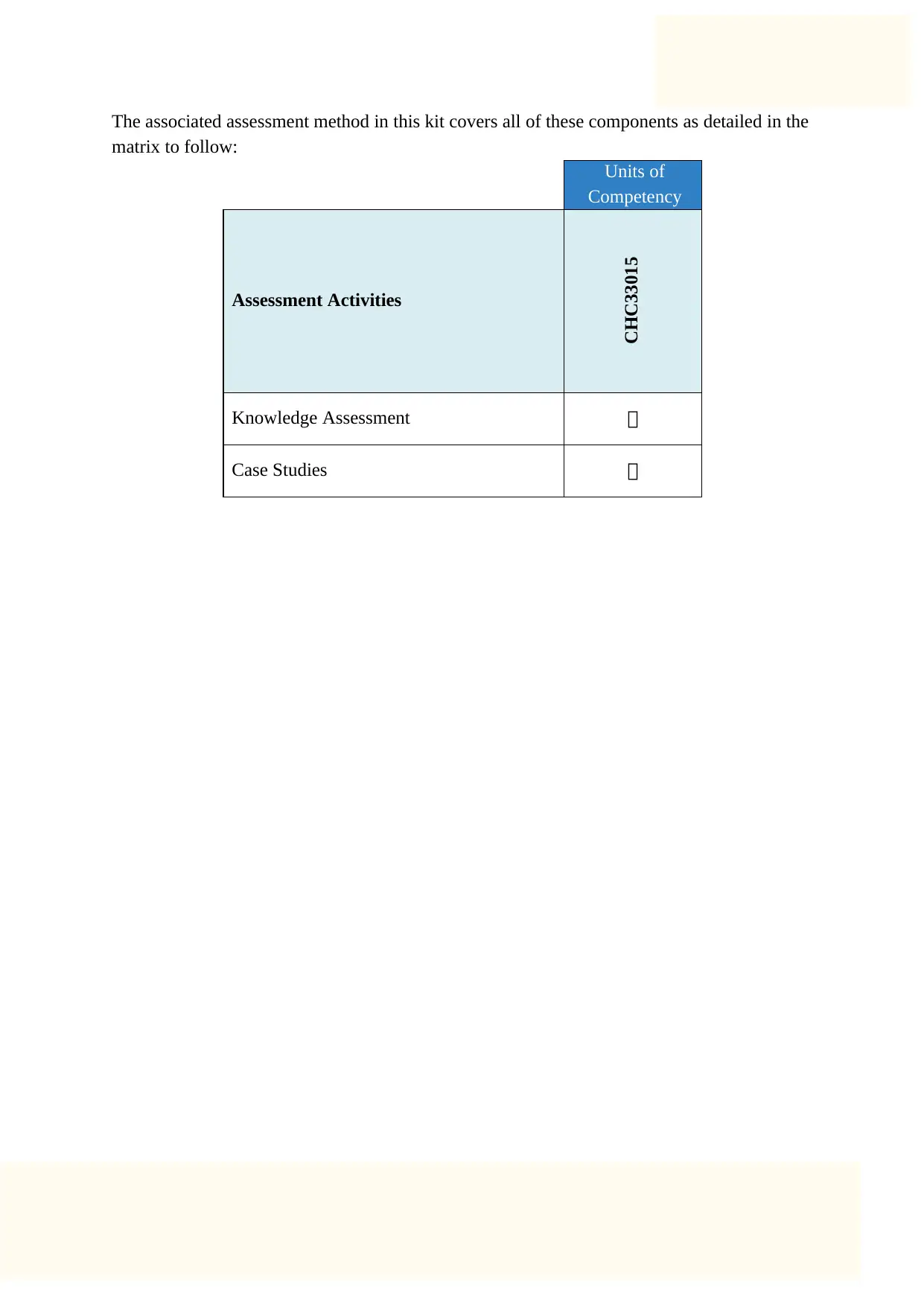
The associated assessment method in this kit covers all of these components as detailed in the
matrix to follow:
Units of
Competency
Assessment Activities
CHC33015
Knowledge Assessment
Case Studies
matrix to follow:
Units of
Competency
Assessment Activities
CHC33015
Knowledge Assessment
Case Studies
⊘ This is a preview!⊘
Do you want full access?
Subscribe today to unlock all pages.

Trusted by 1+ million students worldwide
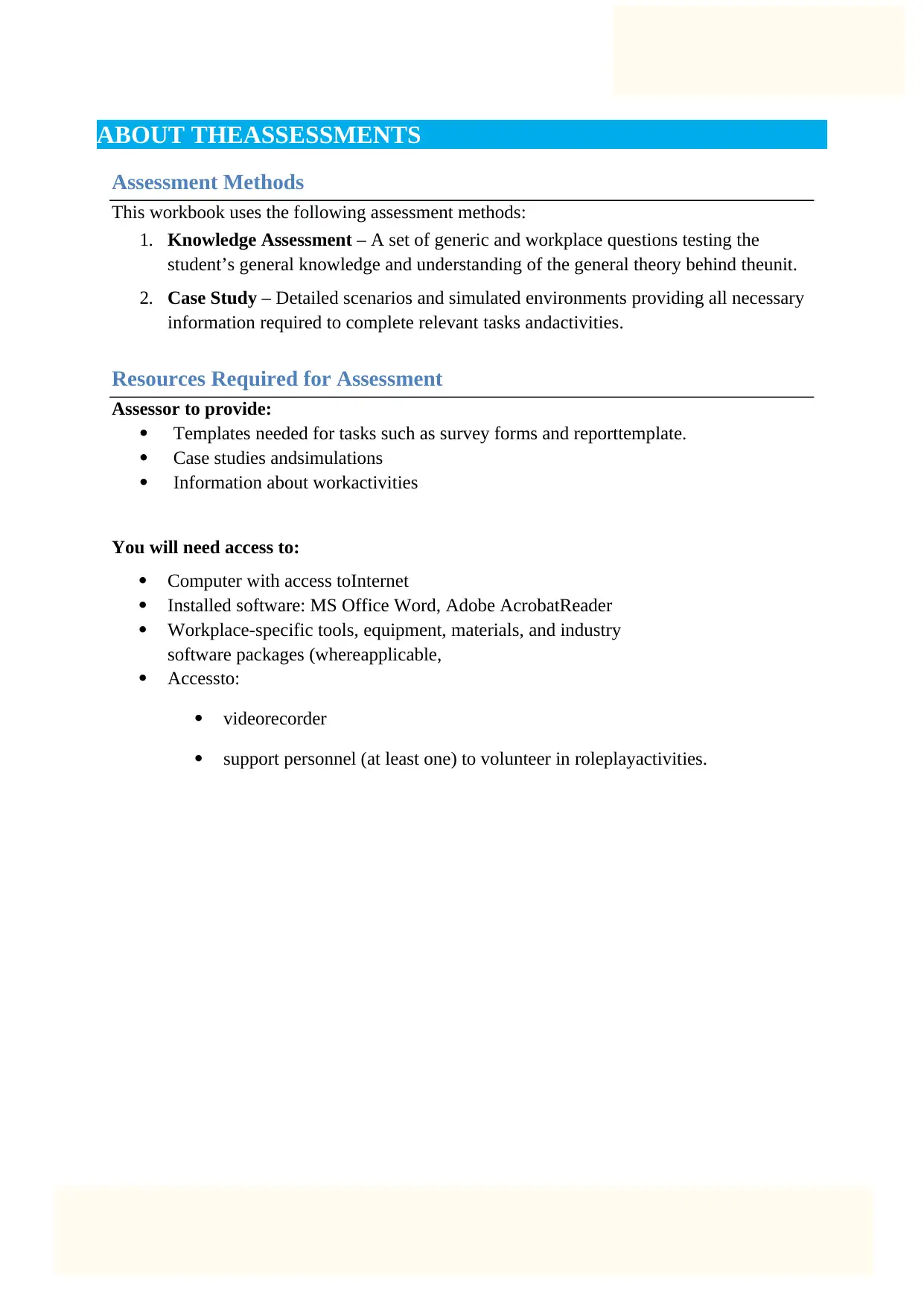
ABOUT THEASSESSMENTS
Assessment Methods
This workbook uses the following assessment methods:
1. Knowledge Assessment – A set of generic and workplace questions testing the
student’s general knowledge and understanding of the general theory behind theunit.
2. Case Study – Detailed scenarios and simulated environments providing all necessary
information required to complete relevant tasks andactivities.
Resources Required for Assessment
Assessor to provide:
Templates needed for tasks such as survey forms and reporttemplate.
Case studies andsimulations
Information about workactivities
You will need access to:
Computer with access toInternet
Installed software: MS Office Word, Adobe AcrobatReader
Workplace-specific tools, equipment, materials, and industry
software packages (whereapplicable,
Accessto:
videorecorder
support personnel (at least one) to volunteer in roleplayactivities.
Assessment Methods
This workbook uses the following assessment methods:
1. Knowledge Assessment – A set of generic and workplace questions testing the
student’s general knowledge and understanding of the general theory behind theunit.
2. Case Study – Detailed scenarios and simulated environments providing all necessary
information required to complete relevant tasks andactivities.
Resources Required for Assessment
Assessor to provide:
Templates needed for tasks such as survey forms and reporttemplate.
Case studies andsimulations
Information about workactivities
You will need access to:
Computer with access toInternet
Installed software: MS Office Word, Adobe AcrobatReader
Workplace-specific tools, equipment, materials, and industry
software packages (whereapplicable,
Accessto:
videorecorder
support personnel (at least one) to volunteer in roleplayactivities.
Paraphrase This Document
Need a fresh take? Get an instant paraphrase of this document with our AI Paraphraser
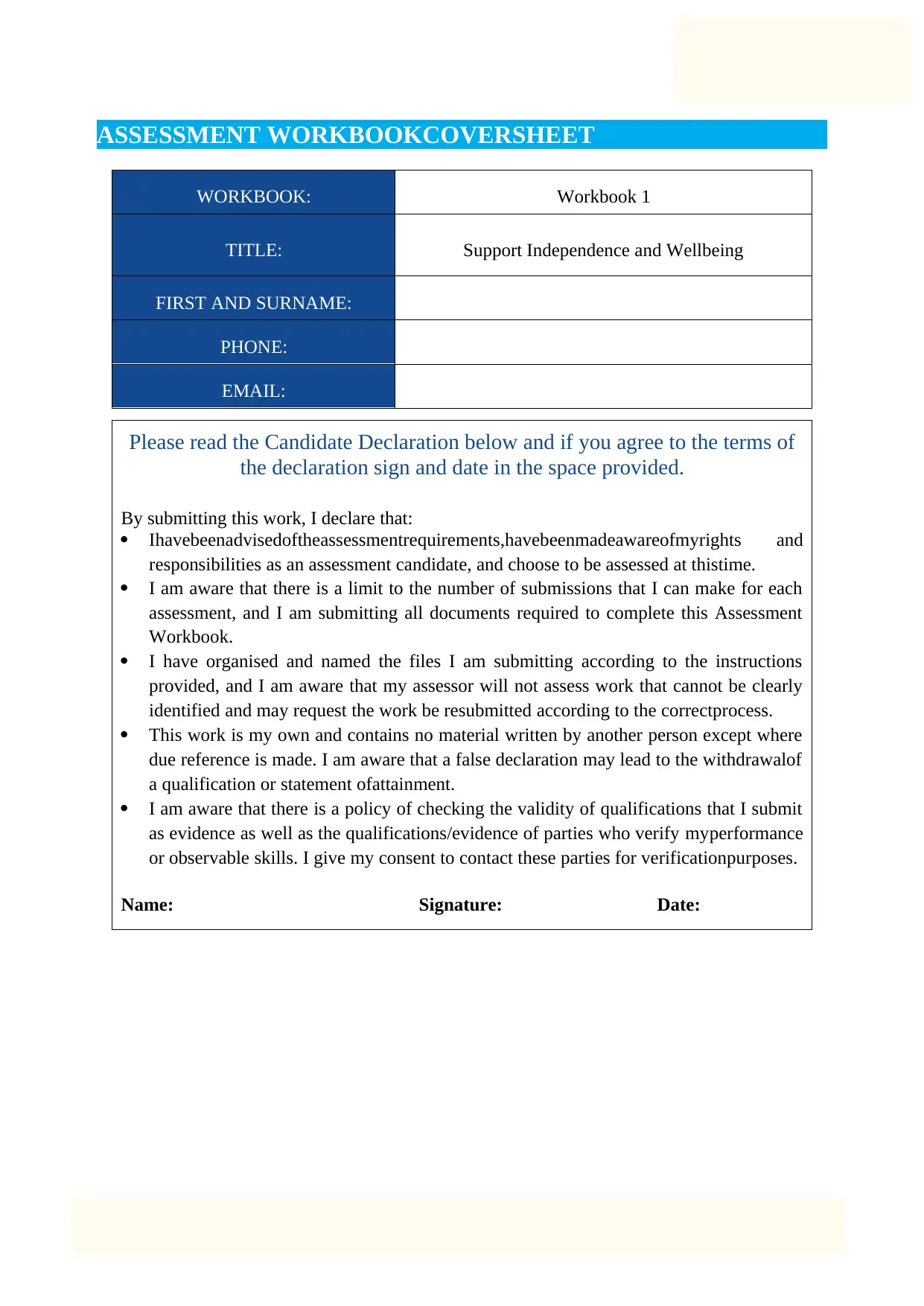
ASSESSMENT WORKBOOKCOVERSHEET
WORKBOOK: Workbook 1
TITLE: Support Independence and Wellbeing
FIRST AND SURNAME:
PHONE:
EMAIL:
Please read the Candidate Declaration below and if you agree to the terms of
the declaration sign and date in the space provided.
By submitting this work, I declare that:
Ihavebeenadvisedoftheassessmentrequirements,havebeenmadeawareofmyrights and
responsibilities as an assessment candidate, and choose to be assessed at thistime.
I am aware that there is a limit to the number of submissions that I can make for each
assessment, and I am submitting all documents required to complete this Assessment
Workbook.
I have organised and named the files I am submitting according to the instructions
provided, and I am aware that my assessor will not assess work that cannot be clearly
identified and may request the work be resubmitted according to the correctprocess.
This work is my own and contains no material written by another person except where
due reference is made. I am aware that a false declaration may lead to the withdrawalof
a qualification or statement ofattainment.
I am aware that there is a policy of checking the validity of qualifications that I submit
as evidence as well as the qualifications/evidence of parties who verify myperformance
or observable skills. I give my consent to contact these parties for verificationpurposes.
Name: Signature: Date:
WORKBOOK: Workbook 1
TITLE: Support Independence and Wellbeing
FIRST AND SURNAME:
PHONE:
EMAIL:
Please read the Candidate Declaration below and if you agree to the terms of
the declaration sign and date in the space provided.
By submitting this work, I declare that:
Ihavebeenadvisedoftheassessmentrequirements,havebeenmadeawareofmyrights and
responsibilities as an assessment candidate, and choose to be assessed at thistime.
I am aware that there is a limit to the number of submissions that I can make for each
assessment, and I am submitting all documents required to complete this Assessment
Workbook.
I have organised and named the files I am submitting according to the instructions
provided, and I am aware that my assessor will not assess work that cannot be clearly
identified and may request the work be resubmitted according to the correctprocess.
This work is my own and contains no material written by another person except where
due reference is made. I am aware that a false declaration may lead to the withdrawalof
a qualification or statement ofattainment.
I am aware that there is a policy of checking the validity of qualifications that I submit
as evidence as well as the qualifications/evidence of parties who verify myperformance
or observable skills. I give my consent to contact these parties for verificationpurposes.
Name: Signature: Date:
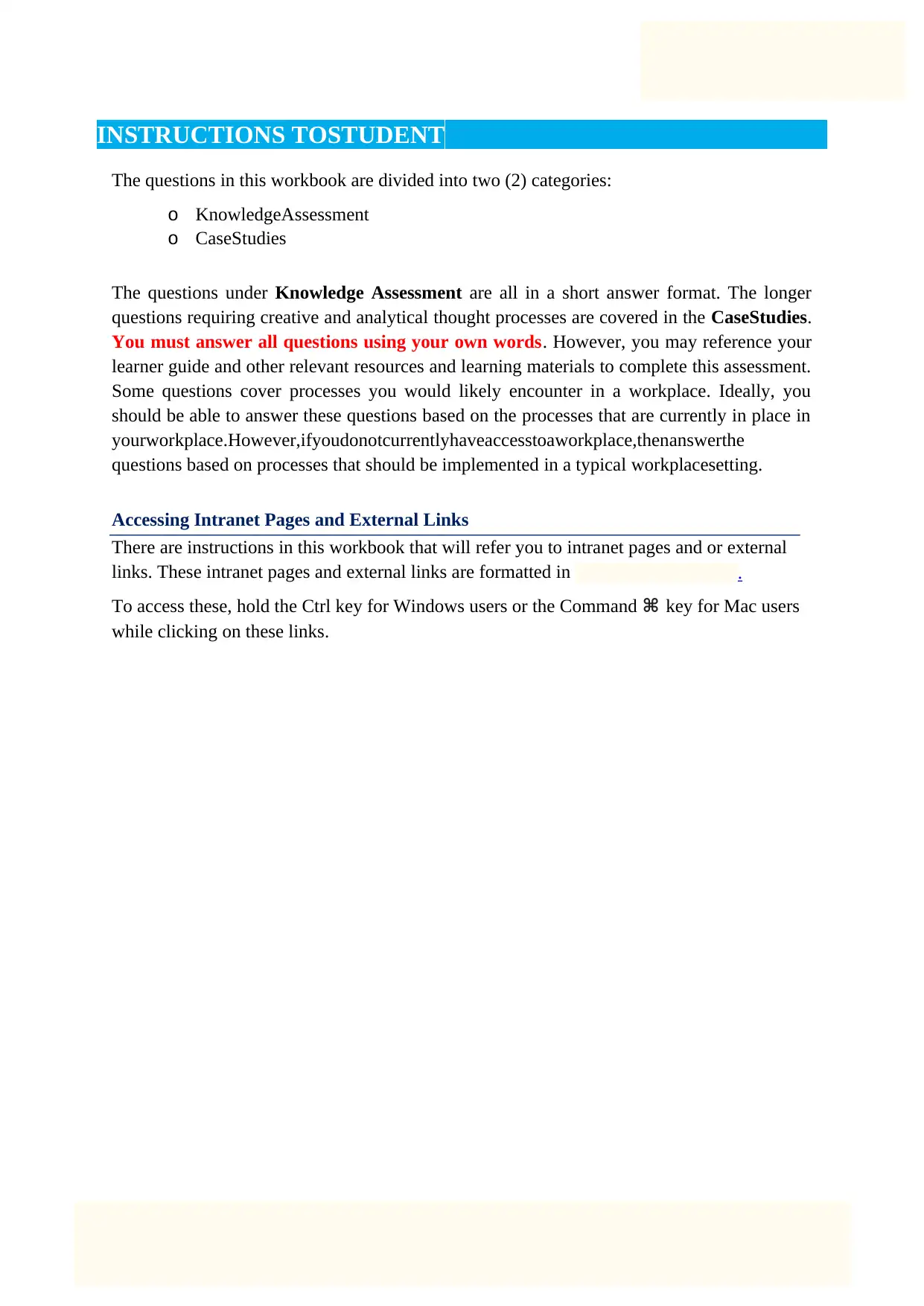
INSTRUCTIONS TOSTUDENT
.
The questions in this workbook are divided into two (2) categories:
o KnowledgeAssessment
o CaseStudies
The questions under Knowledge Assessment are all in a short answer format. The longer
questions requiring creative and analytical thought processes are covered in the CaseStudies.
You must answer all questions using your own words. However, you may reference your
learner guide and other relevant resources and learning materials to complete this assessment.
Some questions cover processes you would likely encounter in a workplace. Ideally, you
should be able to answer these questions based on the processes that are currently in place in
yourworkplace.However,ifyoudonotcurrentlyhaveaccesstoaworkplace,thenanswerthe
questions based on processes that should be implemented in a typical workplacesetting.
Accessing Intranet Pages and External Links
There are instructions in this workbook that will refer you to intranet pages and or external
links. These intranet pages and external links are formatted in
To access these, hold the Ctrl key for Windows users or the Command ⌘ key for Mac users
while clicking on these links.
.
The questions in this workbook are divided into two (2) categories:
o KnowledgeAssessment
o CaseStudies
The questions under Knowledge Assessment are all in a short answer format. The longer
questions requiring creative and analytical thought processes are covered in the CaseStudies.
You must answer all questions using your own words. However, you may reference your
learner guide and other relevant resources and learning materials to complete this assessment.
Some questions cover processes you would likely encounter in a workplace. Ideally, you
should be able to answer these questions based on the processes that are currently in place in
yourworkplace.However,ifyoudonotcurrentlyhaveaccesstoaworkplace,thenanswerthe
questions based on processes that should be implemented in a typical workplacesetting.
Accessing Intranet Pages and External Links
There are instructions in this workbook that will refer you to intranet pages and or external
links. These intranet pages and external links are formatted in
To access these, hold the Ctrl key for Windows users or the Command ⌘ key for Mac users
while clicking on these links.
⊘ This is a preview!⊘
Do you want full access?
Subscribe today to unlock all pages.

Trusted by 1+ million students worldwide
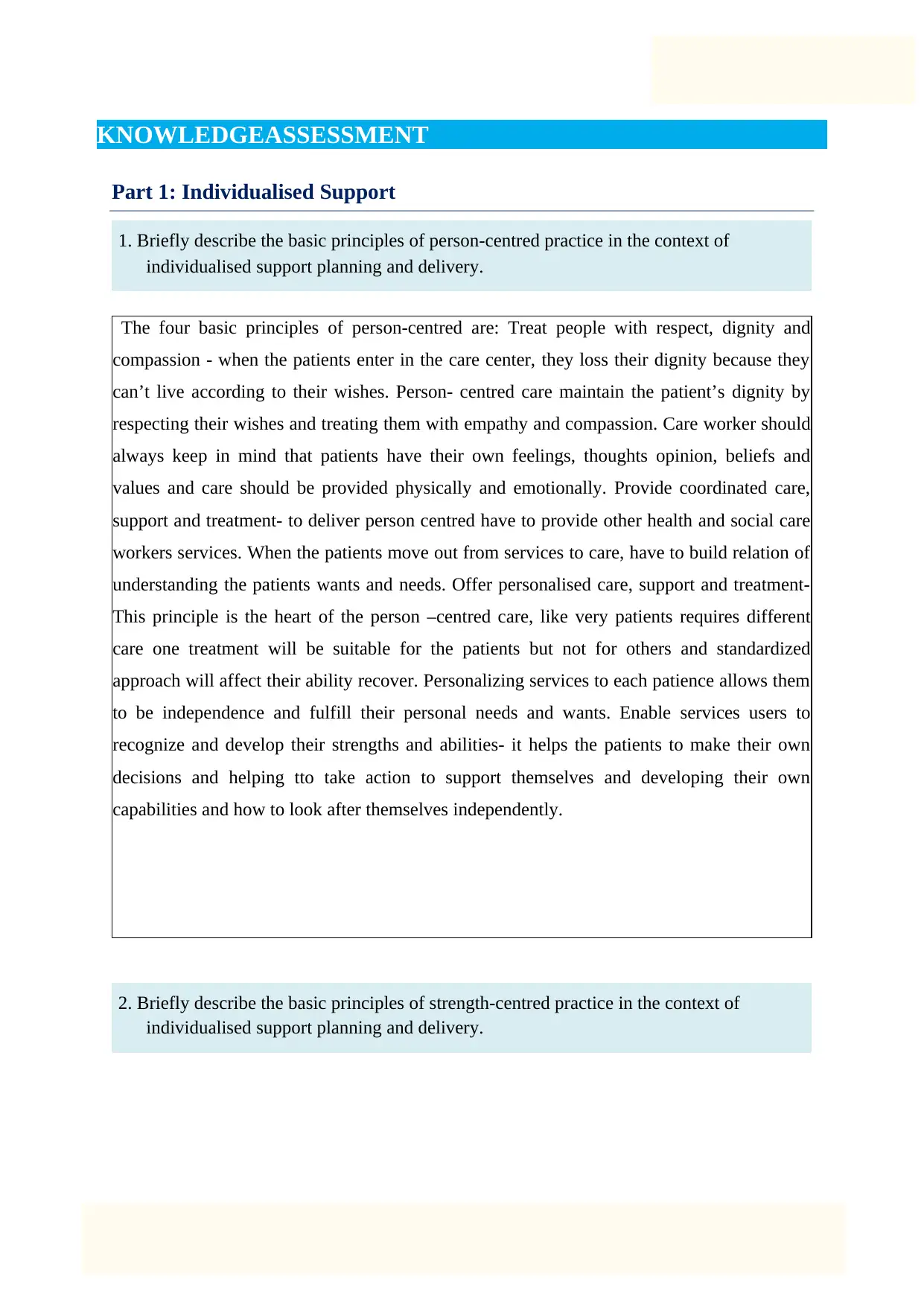
KNOWLEDGEASSESSMENT
1. Briefly describe the basic principles of person-centred practice in the context of
individualised support planning and delivery.
2. Briefly describe the basic principles of strength-centred practice in the context of
individualised support planning and delivery.
Part 1: Individualised Support
The four basic principles of person-centred are: Treat people with respect, dignity and
compassion - when the patients enter in the care center, they loss their dignity because they
can’t live according to their wishes. Person- centred care maintain the patient’s dignity by
respecting their wishes and treating them with empathy and compassion. Care worker should
always keep in mind that patients have their own feelings, thoughts opinion, beliefs and
values and care should be provided physically and emotionally. Provide coordinated care,
support and treatment- to deliver person centred have to provide other health and social care
workers services. When the patients move out from services to care, have to build relation of
understanding the patients wants and needs. Offer personalised care, support and treatment-
This principle is the heart of the person –centred care, like very patients requires different
care one treatment will be suitable for the patients but not for others and standardized
approach will affect their ability recover. Personalizing services to each patience allows them
to be independence and fulfill their personal needs and wants. Enable services users to
recognize and develop their strengths and abilities- it helps the patients to make their own
decisions and helping tto take action to support themselves and developing their own
capabilities and how to look after themselves independently.
1. Briefly describe the basic principles of person-centred practice in the context of
individualised support planning and delivery.
2. Briefly describe the basic principles of strength-centred practice in the context of
individualised support planning and delivery.
Part 1: Individualised Support
The four basic principles of person-centred are: Treat people with respect, dignity and
compassion - when the patients enter in the care center, they loss their dignity because they
can’t live according to their wishes. Person- centred care maintain the patient’s dignity by
respecting their wishes and treating them with empathy and compassion. Care worker should
always keep in mind that patients have their own feelings, thoughts opinion, beliefs and
values and care should be provided physically and emotionally. Provide coordinated care,
support and treatment- to deliver person centred have to provide other health and social care
workers services. When the patients move out from services to care, have to build relation of
understanding the patients wants and needs. Offer personalised care, support and treatment-
This principle is the heart of the person –centred care, like very patients requires different
care one treatment will be suitable for the patients but not for others and standardized
approach will affect their ability recover. Personalizing services to each patience allows them
to be independence and fulfill their personal needs and wants. Enable services users to
recognize and develop their strengths and abilities- it helps the patients to make their own
decisions and helping tto take action to support themselves and developing their own
capabilities and how to look after themselves independently.
Paraphrase This Document
Need a fresh take? Get an instant paraphrase of this document with our AI Paraphraser
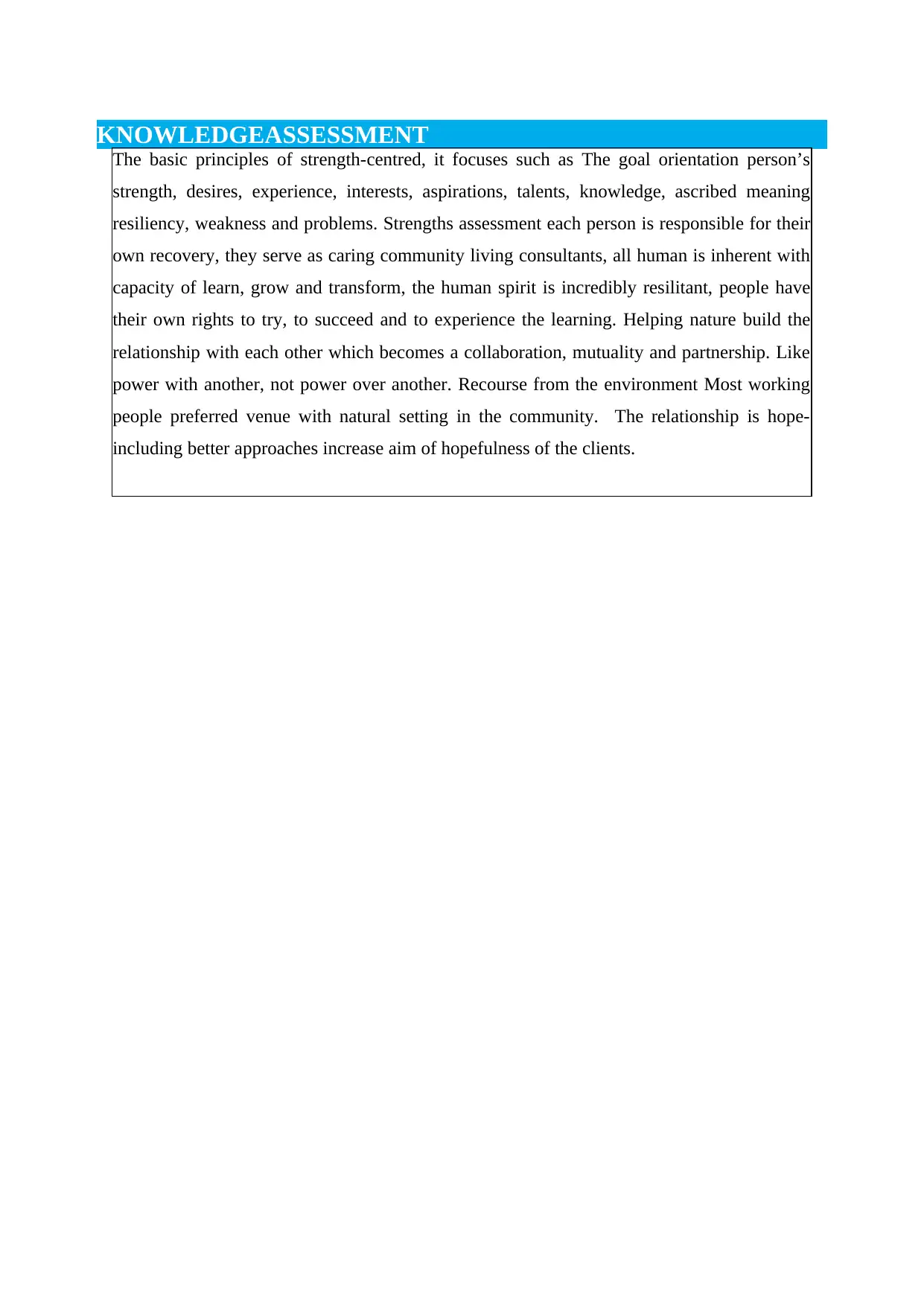
KNOWLEDGEASSESSMENT
The basic principles of strength-centred, it focuses such as The goal orientation person’s
strength, desires, experience, interests, aspirations, talents, knowledge, ascribed meaning
resiliency, weakness and problems. Strengths assessment each person is responsible for their
own recovery, they serve as caring community living consultants, all human is inherent with
capacity of learn, grow and transform, the human spirit is incredibly resilitant, people have
their own rights to try, to succeed and to experience the learning. Helping nature build the
relationship with each other which becomes a collaboration, mutuality and partnership. Like
power with another, not power over another. Recourse from the environment Most working
people preferred venue with natural setting in the community. The relationship is hope-
including better approaches increase aim of hopefulness of the clients.
The basic principles of strength-centred, it focuses such as The goal orientation person’s
strength, desires, experience, interests, aspirations, talents, knowledge, ascribed meaning
resiliency, weakness and problems. Strengths assessment each person is responsible for their
own recovery, they serve as caring community living consultants, all human is inherent with
capacity of learn, grow and transform, the human spirit is incredibly resilitant, people have
their own rights to try, to succeed and to experience the learning. Helping nature build the
relationship with each other which becomes a collaboration, mutuality and partnership. Like
power with another, not power over another. Recourse from the environment Most working
people preferred venue with natural setting in the community. The relationship is hope-
including better approaches increase aim of hopefulness of the clients.
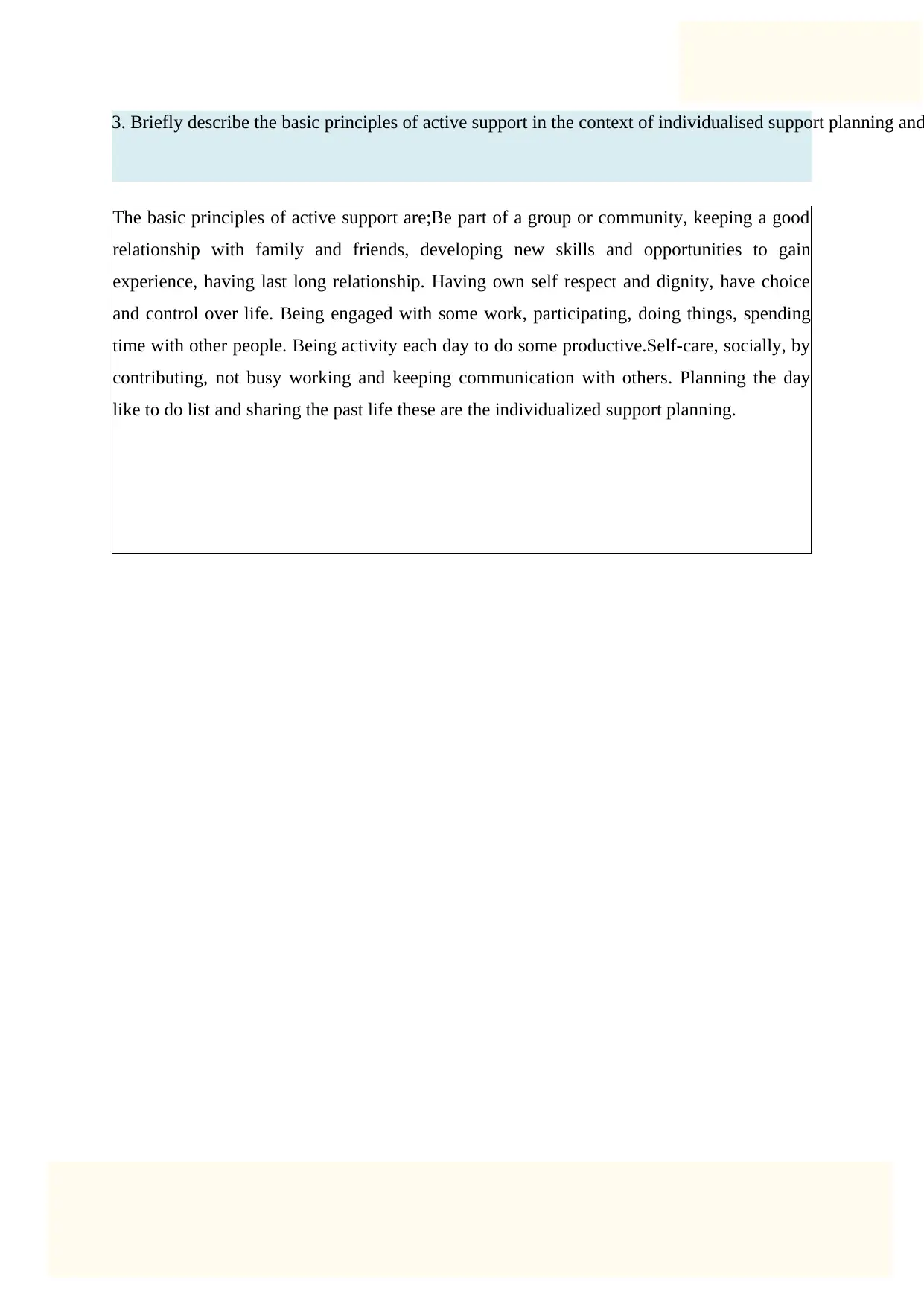
3. Briefly describe the basic principles of active support in the context of individualised support planning and
The basic principles of active support are;Be part of a group or community, keeping a good
relationship with family and friends, developing new skills and opportunities to gain
experience, having last long relationship. Having own self respect and dignity, have choice
and control over life. Being engaged with some work, participating, doing things, spending
time with other people. Being activity each day to do some productive.Self-care, socially, by
contributing, not busy working and keeping communication with others. Planning the day
like to do list and sharing the past life these are the individualized support planning.
The basic principles of active support are;Be part of a group or community, keeping a good
relationship with family and friends, developing new skills and opportunities to gain
experience, having last long relationship. Having own self respect and dignity, have choice
and control over life. Being engaged with some work, participating, doing things, spending
time with other people. Being activity each day to do some productive.Self-care, socially, by
contributing, not busy working and keeping communication with others. Planning the day
like to do list and sharing the past life these are the individualized support planning.
⊘ This is a preview!⊘
Do you want full access?
Subscribe today to unlock all pages.

Trusted by 1+ million students worldwide
1 out of 81
Related Documents
Your All-in-One AI-Powered Toolkit for Academic Success.
+13062052269
info@desklib.com
Available 24*7 on WhatsApp / Email
![[object Object]](/_next/static/media/star-bottom.7253800d.svg)
Unlock your academic potential
Copyright © 2020–2025 A2Z Services. All Rights Reserved. Developed and managed by ZUCOL.





